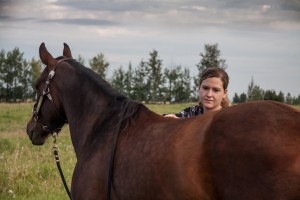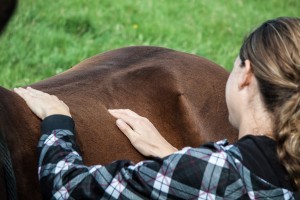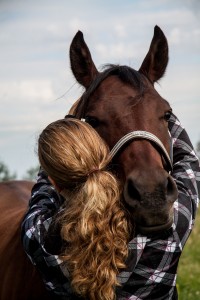As an equine therapist, people often look at me like I have three heads when I tell them what I do for a living. This look is getting less common as time goes and people are recognizing the benefits of providing this type of care for their horses. As equine therapy becomes more popular, there are more and more modality options available to horse owners. Here I will try to answer a few basic questions about equine therapy.
How do I know if my horse would benefit from equine therapy?
 Most horses, just like most people, have some sort of imbalance or pain somewhere. Anyone who has owned a horse knows that they can be accident prone. Injuries will create imbalances and patterns of compensation throughout the body. Our horses also work hard! We ask them to perform athletic manoeuvres while carrying our weight, and there isn’t a horse out there that is perfectly symmetrical.
Most horses, just like most people, have some sort of imbalance or pain somewhere. Anyone who has owned a horse knows that they can be accident prone. Injuries will create imbalances and patterns of compensation throughout the body. Our horses also work hard! We ask them to perform athletic manoeuvres while carrying our weight, and there isn’t a horse out there that is perfectly symmetrical.
In addition there are many aspects of a horses life that are not exactly natural for them; stall life, the tack we use, carrying our weight, wearing shoes, different feeds, and so. While we do all of these things with our horses best interests in mind, it is important to remember that there can be undesirable consequences in addition to the benefits. So with these factors, and then considering the potential of having ill-fitting tack, unbalanced riders, improper shoeing or trimming, equine therapy may be a good consideration for your horse. Different modalities will have different goals and benefits, however most are aimed at relieving pain, improving performance, and overall general well being of the horse.
What Modalities are available for my horse?
 Well, chances are if it’s available for humans, it’s available for your horse. Massage, chiropractic, acupuncture, craniosacral therapy, myofascial release, osteopathy, red light therapy, aromatherapy, energy work and many others are all options for horses. Some practitioners specialize in one particular modality, whereas others have training in various modalities and will use several of them in each session, depending on what is happening with each particular horse.
Well, chances are if it’s available for humans, it’s available for your horse. Massage, chiropractic, acupuncture, craniosacral therapy, myofascial release, osteopathy, red light therapy, aromatherapy, energy work and many others are all options for horses. Some practitioners specialize in one particular modality, whereas others have training in various modalities and will use several of them in each session, depending on what is happening with each particular horse.
How do I choose a practitioner for my horse?
 If you have decided that you’d like to book an appointment for your horse you need to select a practitioner. Doing some searching online can turn up potential options for you, and often talking to other horse people will give you an idea of who is working in your area. Once you have a few options you will want to call each of your options to find out some additional information, as well as take into consideration what modalities you feel would benefit your horse the most. Here is a list of things to ask a potential equine therapist to get you started.
If you have decided that you’d like to book an appointment for your horse you need to select a practitioner. Doing some searching online can turn up potential options for you, and often talking to other horse people will give you an idea of who is working in your area. Once you have a few options you will want to call each of your options to find out some additional information, as well as take into consideration what modalities you feel would benefit your horse the most. Here is a list of things to ask a potential equine therapist to get you started.
How long have you been an equine therapist?
Which modalities do you use and what will my horses session be like?
What sort of training did you do in order to become an equine therapist? This is an important one, as in most areas there are currently no regulations for becoming an equine therapist. This means that someone can take a two year course, a two day course, or no course at all and still call themselves an equine therapist. It is your job to act as your horses advocate, so make sure you decide to use someone that you feel good about.
Do you belong to any professional associations? This may or may not be relevant for your area as associations are not available everywhere yet. The benefits of belonging to a professional association can include things like continuing education requirements, a place to take any complaints you may have, and practitioners carrying liability insurance.
Do you keep records of each session? This shows a degree of professionalism.
Something else to keep in mind is that you want an equine therapist who is willing to be a part of the whole team of people that surround your horse. This means that they are open and willing to communicate and work together with your veterinarian, farrier, barn manager, other therapists and of course you.
How often should I have my horse worked on?
 This depends on a number of factors, including, but not limited to, your horses current state, work load, housing, past incidents, your goals, and so on; and of course your budget. Make sure you discuss this with your therapist so that you are both on the same page. For myself, I always tell clients that they know their horses best and to call me when they feel they need to. I have clients that I see once a year for a tune up and I have clients that I see once a month for a regular maintenance program. Just make sure that your expectations of the results match up with what you are doing!
This depends on a number of factors, including, but not limited to, your horses current state, work load, housing, past incidents, your goals, and so on; and of course your budget. Make sure you discuss this with your therapist so that you are both on the same page. For myself, I always tell clients that they know their horses best and to call me when they feel they need to. I have clients that I see once a year for a tune up and I have clients that I see once a month for a regular maintenance program. Just make sure that your expectations of the results match up with what you are doing!
Another important thing to keep in mind is that your therapist will only see your horse for an hour or two every however often you book. The things that happen between sessions have a much greater impact on your horse than the work the therapist will do; therefore there may be things in your horses life that need to be addressed despite having equine therapy work done on him. For example, if your horses saddle does not fit, you could have his back massaged on a daily basis and it would still be tight and sore. Most therapists are there to help your horse be the best that he can be, so be willing to consider your therapists concerns.
Equine therapy can be a great tool to help keep your horse happy, healthy, sound, and performing at his best.
March 30, 2014
